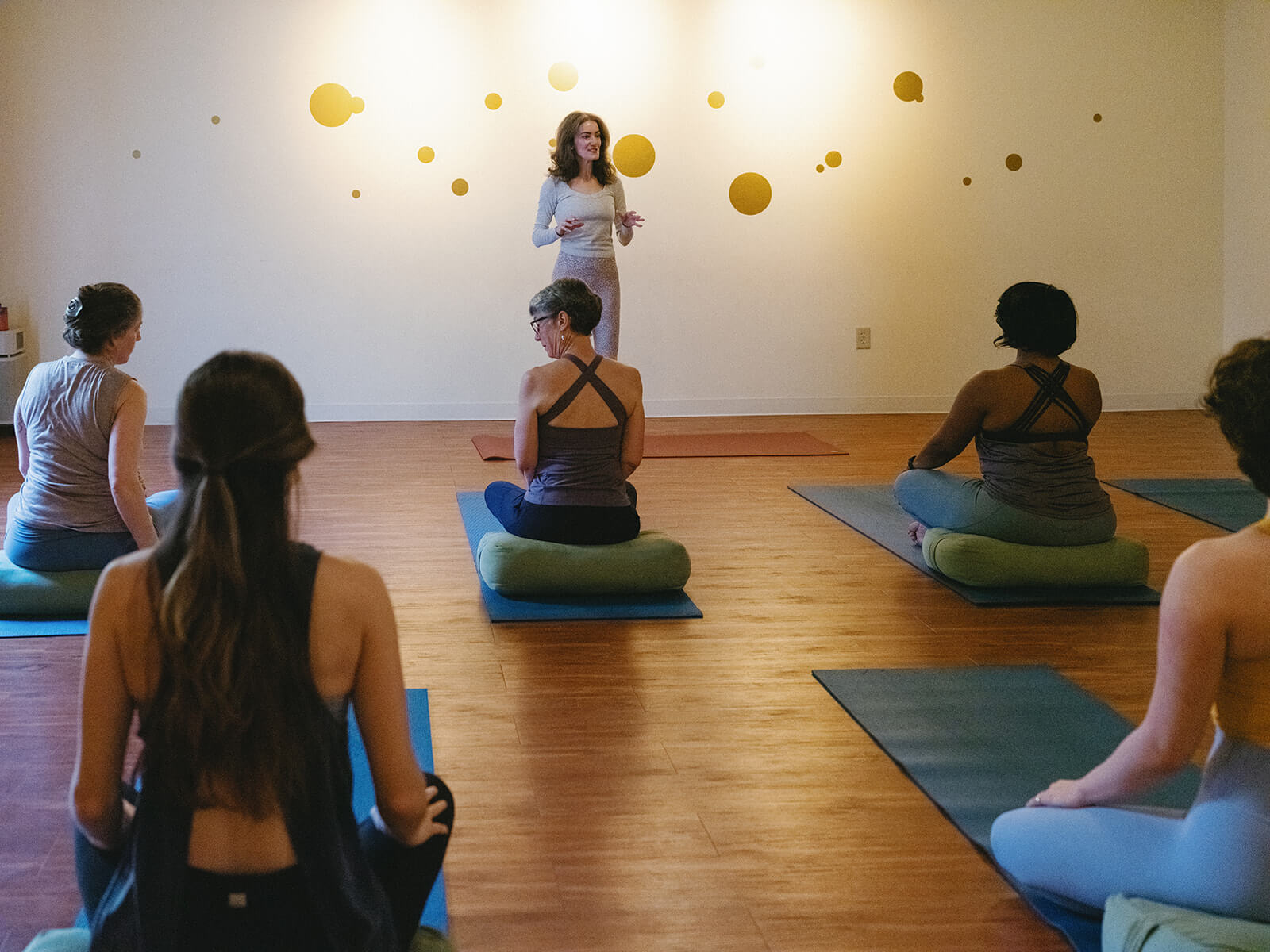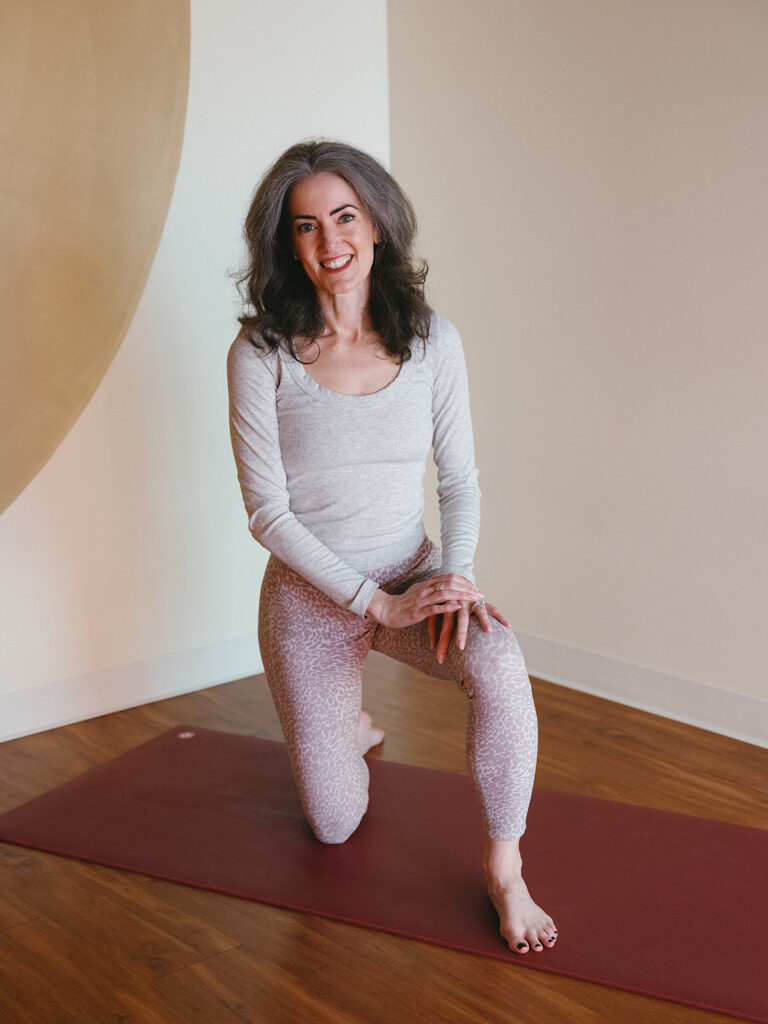In my work with yoga teachers, the same refrain comes up over and over: “I feel burnt out.” “I am spending hours on lesson planning, only to forget what I’d planned!” “I spend all my time on planning and teaching, and it’s killing my passion for my practice.”
These struggles often emerge from our industry’s relentless emphasis on pushing boundaries. You’ve heard it a million times: growth happens beyond your comfort zone! Stretch yourself! No challenge, no change! Feel the fear and do it scared!
And that’s all true—except when it isn’t.
The Teacher’s Comfort Paradox
Here’s what years of teaching has shown me: teachers who operate from their comfort zone actually create better learning environments for students, whether the class focuses on pushing their boundaries of discomfort or on teaching them to lean in to comfort. When we teach from a place of ease and confidence, our nervous systems remain regulated, which helps our students’ systems regulate in turn.
This is especially vital now. In an era where we’re constantly under unprecedented levels of stress—political, environmental, and personal—spending time in the comfort zone isn’t just a luxury, it’s a necessity. Paying attention to comfort, to self-care, to recovery, and to how it feels to work from what we know we can do in our area of genius: these are all critical for our well-being as teachers, as thinkers, as workers, as humans.
Rethinking the Comfort Zone
The comfort zone is often defined as a place where you operate without fear of failure. It’s typically modeled as a smaller circle inside a bigger circle, usually labeled the growth zone. The implication is that real growth requires pushing through discomfort. But when we’re always on high alert, always chasing the next challenge, we don’t grow—we break down.
This is true physiologically and psychologically.
The Physiological Cost of Constant Challenge
Just like you couldn’t stay awake indefinitely without your body giving up and falling asleep, you can’t constantly push yourself outside of your comfort zone. There must be balance between making and letting, between working and rest.
When we chronically activate our sympathetic nervous system (“fight-or-flight”), we trigger a cascade of stress hormones including cortisol and adrenaline. These hormones are essential for survival in true emergencies but destructive when constantly elevated.
Signs You May Need More Comfort Zone Time:
- You feel wired but tired at the end of teaching
- You struggle to recall sequences you’ve taught dozens of times
- Small logistical challenges feel overwhelming
- You’ve lost the spark that initially drew you to teaching
- You notice yourself dreading classes you once loved
You can’t run long runs back to back to back. You can’t lift heavy on leg day four days in a row. And you can’t teach 5, 10, or 15 classes a week with new sequences every time.
There must be cyclicality between the pushing and the pulling, between putting out effort and taking on ease.
Psychological Balance: The Recovery Paradox
The same thing is true for your mind and spirit. Trying to always be pushing our perceived limits, intentionally exposing ourselves to our triggers, going against our natural tendencies. It is exhausting to always be pushing without spending equal or greater attention to allowing this work to sink in. We must carefully balance work with rest.
This creates what I call “The Recovery Paradox”: sometimes the most challenging thing for driven professionals is to embrace ease.
The Irony of Overvaluing Discomfort
Growth happens beyond the comfort zone, sure. The refrigerator magnet is right: NO CHALLENGE, NO CHANGE.
But too many of us have gotten too comfortable with discomfort. We’re conditioned to push, to hustle, to grind—often at the expense of our well-being.
And the irony here is that by not being able to relax and let go, we’re hampering our own ability to absorb the benefits of our hard work. By disregarding rest, ease, and comfort, we miss out on the very optimization we were trying to achieve.
I see this all the time in the yoga studio. Even after a challenging physical practice, students struggle to settle in final relaxation. They squirm, they tap their fingers and toes, they are so used to pushing that they can’t enjoy the fruits of their labors.
For these students, the real challenge is to cultivate the opposite: to be OK with just being OK.
What if, instead of constantly chasing discomfort, we got comfortable with being comfortable? What if we recognized that ease isn’t the enemy, but an essential part of resilience?
Lessons from Endurance Sports
As an endurance sports coach, my job was to design challenges to help athletes push their perceived limits and discover new abilities. But I also knew that pushing wasn’t enough. Intentional application of stress is only one side of the training formula: training = stress + rest. Rest and recovery were just as critical—so much so that I wrote a book about what to do when you aren’t working out, The Athlete’s Guide to Recovery. Training without rest doesn’t lead to progress; it leads to injury and burnout.
Many athletes come to yoga looking for another challenge, eager to build comfort with discomfort. That’s great—but they’re already experts at pushing themselves. What they actually need is comfort with comfort. The ability to relax, recover, and recalibrate so they can push again when the time is right.
Yoga teachers face a remarkably similar challenge. Just like athletes who constantly push their physical limits, yoga teachers push their creative and emotional resources to the brink. The constant (self-imposed!) pressure to develop fresh sequences, provide individualized attention to every student, market classes, and maintain their own practice creates a perfect storm.
Many teachers feel an unspoken pressure to be “on” all the time—to embody a perfect practice, demonstrate advanced poses, and deliver transformative experiences class after class. This perfectionism creates a physiological toll that’s rarely acknowledged in our profession. Just as we guide our students toward recovery and restoration, we yoga teachers must learn to embrace periods of ease and repetition in our teaching.
The consequences of ignoring this balance are just as real for us as they are for high-performance athletes: compromised immune function, inflammation, burnout, and eventually, falling out of love with the very practice we’re dedicated to sharing.
The Balance of Sthira and Sukha: A Framework for Sustainable Teaching
Yoga philosophy teaches the balance of sthira (effort) and sukha (ease). This ancient wisdom offers a framework for how we approach both our practice and our teaching:
| Too Much Sthira (Effort) | Balanced | Too Much Sukha (Ease) | |
| Teaching Impact | Burnout, complexity for its own sake | Sustainable growth, effective teaching | Stagnation, lack of innovation |
| Student Experience | Overwhelm, intimidation | Appropriate challenge with support | Boredom, plateau |
| Teacher Experience | Exhaustion, resentment | Fulfillment, confidence | Disengagement, loss of passion |
Sustainable growth comes from knowing when to push and when to pause. Expanding our comfort zones doesn’t mean abandoning them—it means growing from a place of support and stability.
Why Yoga Teachers Burn Out
Yoga teachers, too, tend to make things harder than they need to be. They overcomplicate their sequences, reinvent the wheel for every class, and try to spend their entire careers in the growth zone, chasing validation through complexity.
But mastery isn’t about making things harder—it’s about making them more effective. Embracing the comfort zone can build confidence, sustainability, and longevity in teaching.
My mentees in Mastering the Art of Yoga Sequencing: A Mentorship Membership, one of my premier offerings at Comfort Zone Yoga, regularly say that making their teaching more consistent has freed up their energy and built their student retention. What a great win/win!
If the comfort zone is indeed where we can operate without fear of failure, why wouldn’t we want that for our teaching? We serve our students best when we are calm, confident, and controlled. That’s how we can model equanimity for them and how our own regulated nervous systems can invite theirs into balance.
Welcome to Comfort Zone Yoga
This philosophy is exactly why I named my virtual studio focused on teacher development Comfort Zone Yoga.
Yes, we focus on the softer styles of yoga—I’m building out trainings on teaching gentle, yin, and restorative yoga, trauma-informed yoga, and yoga nidra. But I’m also developing courses on teaching challenging balance classes and core-strength classes. It’s not all dessert all the time—but dessert has its place in the meal. You can’t thrive on only salad!
Comfort Zone Yoga isn’t about complacency. It’s about sustainability. It’s about creating a space where yoga teachers and students alike can find ease, trust their skills, and grow from a foundation of support. It’s a reframe: instead of treating comfort as something to escape, what if we treated it as something to cultivate?
Join the Zone: Where Teachers Find Their Comfort
The Zone is our free community where yoga teachers come together to embrace this philosophy. Here’s what members experience:
- Weekly discussion prompts that challenge conventional teaching wisdom
- Real-time problem-solving with peers facing similar teaching challenges
- Resources sharing that saves you hours of sequence planning
- Validation that simple, effective teaching is often better than complex novelty
- Connection with hundreds of colleagues who believe in balancing comfort and growth
What if leaning in to our softness, to our expertise, to the things we can accomplish with ease, made us better teachers and better people? That’s what we are doing at Comfort Zone Yoga, and especially in the Zone.
Yes, growth happens beyond the comfort zone. But so does burnout. True, sustainable progress requires balance—the ability to push when needed, and the wisdom to recover when necessary. Comfort isn’t the enemy of growth. It’s the foundation that makes growth possible.
Ready to find your teaching comfort zone? Join over 700 of your colleagues in the Zone to ask questions, share ideas, and build better comfort in the front of your classroom. Sign up for free at www.comfortzoneyoga.com.


